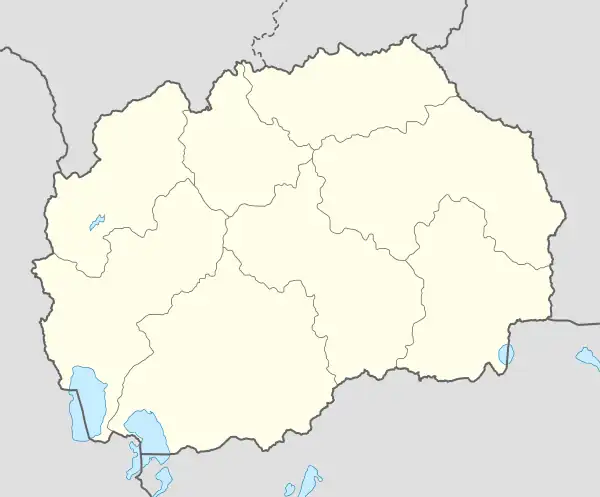Bačišta
Bačišta (Macedonian: Бачишта, Albanian: Baçisht) is a village in the municipality of Kičevo, North Macedonia. It used to be part of the former Zajas Municipality. The village has an Albanian school and a mosque.[1]
Bačišta
Бачишта Baçisht | |
|---|---|
Village | |
 Bačišta Location within North Macedonia | |
| Coordinates: 41°36′N 20°54′E | |
| Country | |
| Region | |
| Municipality | |
| Population (2021) | |
| • Total | 470 |
| Time zone | UTC+1 (CET) |
| • Summer (DST) | UTC+2 (CEST) |
| Car plates | KI |
| Website | . |
History
The village is attested in the 1467/68 Ottoman tax registry (defter) for the Nahiyah of Kırçova. The village had a total of 34 houses, excluding bachelors (mucerred).[2]
The village population consists of a traditionally Albanien Muslim speaking population that is surrounded by Muslim Albanian villages.[3] population is Albanian.[4] Common language and origin with Macedonian Christians does not play a role for a majority of Torbeš regarding self-identification which is based on common religion (Islam).[4] In the 1990s parents from Bačišta refused to send their children to the local village Macedonian language school and the introduction of Albanian schooling was attempted.[3][4] Inhabitants of Bačišta have claimed to be Macedonianized Albanians.[3] In 1992 Albanian schooling until the 8th grade was introduced in Bačišta.[4]
Demographics
In statistics gathered by Vasil Kanchov in 1900, the village of Bačišta was inhabited by 450 Muslim Bulgarians.[5] The Yugoslav census of 1953 recorded 501 people of whom 407 were Albanians, 26 Macedonians, 1 Turks and 7 others.[1] The 1961 Yugoslav census recorded 527 people of whom 514 were Albanians, 4 Turks, 2 Macedonians and 7 others.[1] The 1971 census recorded 642 people of whom 612 were Albanians, 20 Turks, 2 Macedonian and 8 others.[1] The 1981 Yugoslav census recorded 646 people of whom 581 were Albanians, 34 Macedonians, 3 Turks, 13 Bosniaks and 15 others.[1] The Macedonian census of 1994 recorded 685 people of whom 684 were Albanians and 1 other.[1]
As of the 2021 census, Bačišta had 470 residents with the following ethnic composition:[6]
- Albanians 443
- Persons for whom data are taken from administrative sources 25
- Roma 2
According to the 2002 census, the village had a total of 772 inhabitants.[7] Ethnic groups in the village include:[7]
- Albanians 756
- Macedonians 1
- Others 15
Mother tongues in the language was as follows
- Albanian 755
- Macedonian 1
- Serbian 1
- Other 15
References
- Sherafedin Kaso (2005). The settlements with Muslim population in Macedonia. Logos-A. p. 19. ISBN 978-9989-58-155-7.
- Qerim Dalipi. "NAHIJA E KËRÇOVËS SIPAS REGJISTRIMIT TË VITEVE 1467-1468 (Aspekte shoqërore)". Gjurmime Albanologjike - Seria e shkencave historike 47:29-48.
- Friedman, Victor (1993). "Language Policy and Language Behavior in Macedonia: Background and Current Events". In Fraenkel, Eran; Kramer, Christina (eds.). Language Contact – Language Conflict (PDF). New York: Peter Lang. p. 98. ISBN 978-0700713790.
- Telbizova-Sack, Jordanka (2005). "Eine Identität mit vielen Gesichtern? Die slawischen Muslime Makedoniens". In Keul, István (ed.). Religion, Ethnie, Nation und die Aushandlung von Identität(en): regionale Religionsgeschichte in Ostmittel- und Südosteuropa. Frank & Timme GmbH. ISBN 9783865960092. p. 56. "Für den großten Teil der makedonischen Muslime speilt die gemeinsame Herkunft und Sprache mit der makedonischen Mehrheit jedoch kaum eine Rolle. Wenn sie sich nach außen deklarieren müssen, geben sie sich - unter dem Hinweis, dass es im Islam keine Nationen gibt -liber als Türken oder Albaner aus."; p. 57. "Vor allem in den Siedlungsgebieten von Debar, südlich von Skopje und im Kičevska-Tal bestimmten sich die bezüglich ihrer ethnischen Identität tief verunsicherten Torbeschen bei den Volkszählungen von 1994 überwiegend als "Turken", ungeachtet der Tatsache, dass die Kenntnis der türkischen Sprache unter ihnen schwach oder überhaupt nicht vorhanden war. Eine schwächere Tendenz, in Richtung Bekenntnis zum albanischen Ethnikum, zeichnete sich in der südwestlichen Struga-Region (Dorf Labunište) sowie im Dorf Bačište (Kičevo-Gemeinde) ab." pp.57-58. In den südwestlichen Dörfern Labunište und Bačište, in denen sich die Bewohner zum Teil als Albaner bezeichen, gab es Versuche, die albanische Sprache als Unterichtssprache einzuführen."; p.58. "In Bačište wurde seit 1992 von der ersten bis zur achten Klassenstufe die albanische Sprache fakultativ eingeführt."
- Vasil Kanchov (1900). Macedonia: Ethnography and Statistics. Sofia. p. 255.
- Total resident population of the Republic of North Macedonia by ethnic affiliation, by settlement, Census 2021
- Macedonian Census (2002), Book 5 - Total population according to the Ethnic Affiliation, Mother Tongue and Religion, The State Statistical Office, Skopje, 2002, p. 102.